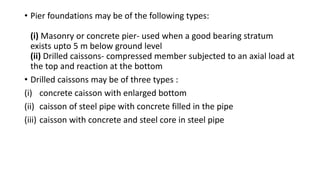Foundations transmit loads from buildings to the ground below. There are different types including shallow foundations like spread footings and deep foundations like piles. Spread footings support individual columns on isolated slabs while combined footings link two columns. Strap footings connect isolated footings with a beam. Mat foundations are large slabs supporting many columns. Pile foundations transfer loads to deeper soils through friction or bearing. Foundations can fail due to unequal settlement, subsoil moisture movement, lateral pressures, or weathering effects. Proper design and construction seeks to prevent these failures.


















